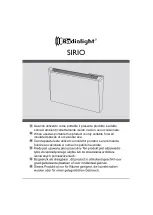
43
(1 or multiple) and proceeds to Pump Purge
mode.
10. The VERSA IC Control will turn on the system,
boiler and/or DHW pump as necessary to address
the call-for-heat. This is dependent on the Mode of
operation selected. The pumps will proceed
through their purge period before the control will
move into a Trial for Ignition (TFI). For systems
with CWP enabled, the MIX output is sent to the
MIX MIN % value.
11. The VERSA Control Board and PIM check the
safety circuit and will stop from going into a trial for
ignition if any of the safety devices is in an
error/fault condition.
12. If no fault condition is found, the air pressure
switch (if present) is verified to be in the open
position before the blower is energized.
13. The blower(s) are energized.
14. The air pressure switch is verified to close within
60 seconds to prove air flow.
15. Once the air pressure switch closes, the blowers
proceed to pre-purge for the specified duration.
16. At this point all safeties have been verified and
Primary PIM activates the Interlock Signal, which
indicates to the Secondary PIM that it is ready to
attempt an ignition sequence whenever the
VERSA Control Board indicates.
17. The voltage level of the 24VAC supply input is
confirmed to be above 18.0VAC – if not, a Low
Voltage fault will be recorded and the heater will
go into a soft lockout condition until the voltage
rises above 18.0VAC consistently.
18. If all checks have passed, the system proceeds to
ignition.
19. Either Primary or Secondary PIM (depending on
the rotation sequence) re-initializes the ignition
counter to the configured number of trials (typical-
ly 1 or 3). (For the sequence of operation
description it is assumed that the Primary PIM is
leading the rotation sequence)
20. The Hi Limit sensor is confirmed to read below the
Hi Limit setpoint.
21. The gas valve relay contacts are verified open – if
closed, a fault code will be issued and the heater
will post-purge and go into a hard lockout condi-
tion.
22. The Hi Delta units are equipped with a Hot
Surface Igniter:
a. The Primary PIM control turns on the HSI and
the HSI proving current is verified to be above
the configured value.
b. The configured heat-up delay takes place to
allow the HSI element to reach ignition tem-
perature.
c. The “Gas Valve 1” output (from Primary PIM)
is energized for the trial for-ignition time to
light the burner.
d. The HSI is de-energized during the last sec-
ond of the trial-for-ignition period to sense for
the burner flame.
e. The flame sense is checked for successful
lighting of the burner. If a valid flame is detect-
ed, the main gas valve, operating pumps and
blower relay remain energized and the
Primary PIM proceeds to the Heating mode.
f. For systems with CWP enabled, the MIX out-
put is released to its control point based on
distance from Inlet temperature target.
g. (2002C-2342C) when power is sent from
Primary PIM to main gas valve (1) it is also
sent to Time Delay Relay 1 (TDR-1), which
starts a 5-sencond countdown.
h. (2002C-2342C) after the 5-second countdown
TDR-1 energizes Gas Valve 1A.
i. The second stage will be triggered by the
Primary PIM using the second relay build into
the Primary PIM hardware (J14- 2, 5).
j. When heat demand is reached the Primary
PIM will be required by the VERSA Control
Board to activate Gas Valve 2.
k. At this point if the Interlock remains activated
and heat demand is still present, the
Secondary PIM is called to continue the ramp
up process.
l. The Secondary PIM control turns on the HSI
and the HSI proving current is verified to be
above the configured value.
Summary of Contents for 992C
Page 54: ...54 Wiring Diagram Models 992C 1262C...
Page 55: ...55 Wiring Diagram Models 1532C 2342C...
Page 69: ...69...
Page 70: ...70...
Page 71: ...71...
















































